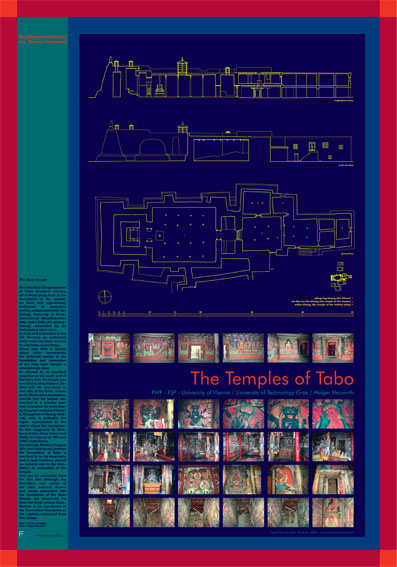
The Tabo Main Temple consists
of three structural entiries, all of them going back to the foundation
of the temple: an
Entry Hall
(sgo-khang)
dedicated to protective deities, an Assembly Hall (’du-khang) featuring
a three-dimensional Vajradhatuman-dala, and a Cella (dri-gtsang-khang)
surounded by an Ambulatory (skor-lam). In front of the entrance to the
old structure an additional entry room has been erected in relatively
recent times. Given how little is known about other monuments, the historical
context of the foundation and renovation of the Tabo Main Temple is astonishingly
clear. As attested by an inscribed depiction on the south wall of the
Entry Hall, the temple was founded by king Yeshe-ö (Ye-shes-’od).
An inscription to one side of the Cella, known as the Renovation Inscription,
records that the temple was founded in a monkey year and renovated 46
years later by the great-nephew of Yeshe-ö, Changchub-ö (Byang-chub-’od),
who is probably the figure represented in the centre above the inscription.
As first suggested by Klim-burg-Salter, these dates most likely correspond
to 996 and 1042 respectively. Surprisingly, Rinchen Zangpo (Rin-chen-bzang-po),
to whom the foundation of Tabo is ascribed to in his biography and in
local tradition, played
no decisive role in the foun-dation or renovation of the temple. This
can be concluded from the fact that although the depictions and names
of the most eminent donors and monks associated with the foundation
of the Main Temple are preserved, he does not occur among these. Neither
is he mentioned in the Renovation Inscription or the captions preserved
from that phase.
Text: Christian Luczanits
Fotos: Holger Neuwirth